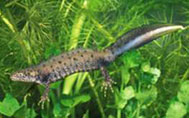
NEWTS
SURVEY TECHNIQUES
Surveys
As they have such a high level protection, all Newt survey techniques must be conducted by licensed individuals. As newts are largely nocturnal, surveying is best conducted at night, and during the breeding period of mid March to mid June. Four visits are required to determine whether newts are present on the site, while six visits to estimate population size class. In either case, 50% of the visits must take place between mid April and mid May. A combination of techniques is used on each occasion:
- Egg search – Eggs of this species are larger than the other species (about 5mm in diameter), and are laid on the leaves of submerged plants which are then neatly folded over
- Torching – High power torches are used to shine into the shallow margins of ponds at night when newts are most active
- Bottle trapping – Un-baited plastic bottle traps are submerged along the pond margins in the evening, they are then checked and removed the following morning.. Newts swim into the traps and are unable to escape until released
- Terrestrial search – Suitable habitats such as logs, rubble, discarded carpet and wood are carefully inspected underneath and then replaced. This search does not need be carried out during the breeding season, and is usually done in the daytime
Mitigation where Great Crested Newts are discovered might include modification of building works or time scales to avoid interfering with migrating animals, the installation of newt-proof exclusion fences (temporary or permanent) or the relocation of newts to new ponds which have been specially created to accommodate them.


















